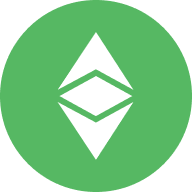Ethereum Classic price
in USD

About Ethereum Classic
Disclosures
Ethereum Classic risk
This material is for informational purposes only and is not exhaustive of all risks associated with trading Ethereum Classic. All crypto assets are risky, there are general risks in investing in Ethereum Classic. These include volatility risk, liquidity risk, demand risk, forking risk, cryptography risk, regulatory risk, concentration risk & cyber security risk. This is not intended to provide (i) investment advice or an investment recommendation; (ii) an offer or solicitation to buy, sell, or hold crypto assets; or (iii) financial, accounting, legal or tax advice. Profits may be subject to capital gains tax. You should carefully consider whether trading or holding crypto assets is suitable for you in light of your financial situation. Please review the Risk Summary for additional information.
Investment Risk
The performance of most crypto assets can be highly volatile, with their value dropping as quickly as it can rise. You should be prepared to lose all the money you invest in crypto assets.
Lack of Protections
Crypto assets are largely unregulated and neither the Financial Services Compensation Scheme (FSCS) nor the Financial Ombudsman Service (FOS) will protect you in the event something goes wrong with your crypto asset investments.
Liquidity Risk
There is no guarantee that investments in crypto assets can be easily sold at any given time.
Complexity
Investments in crypto assets can be complex, making it difficult to understand the risks associated with the investment. You should do your own research before investing. If something sounds too good to be true, it probably is.
Concentration Risk
Don't put all your eggs in one basket. Putting all your money into a single type of investment is risky. Spreading your money across different investments makes you less dependent on anyone to do well. A good rule of thumb is not to invest more than 10% of your money in high-risk investments.
Five questions to ask yourself
- Am I comfortable with the level of risk? Can I afford to lose my money?
- Do I understand the investment and could I get my money out easily?
- Are my investments regulated?
- Am I protected if the investment provider or my adviser goes out of business?
- Should I get financial advice?
Ethereum Classic’s price performance
Ethereum Classic on socials
Guides

Create a free OKX account
Fund your account
Choose your crypto
Ethereum Classic FAQ
There is no staking infrastructure on Ethereum Classic as the blockchain favors a mining-based system for validating transactions. Hence, it is only possible to stake ETC if a third-party solution offers staking or yield-generating services for ETC. For instance, you can earn interest when you subscribe to the ETC staking plans on OKX Earn, available in both flexible and fixed terms.
Unlike Ethereum, which has no supply limit, ETC supply is limited to 210.7 million tokens. This is because ETC has adopted a deflationary approach where the scarcity of tokens over time is expected to drive up ETC prices.
The emission reduction schedule of ETC initiates after 5 million blocks have been added to the blockchain. The upcoming block reward reduction will occur sometime in the third quarter of 2024.
Easily buy ETC tokens on the OKX cryptocurrency platform. Available trading pairs in the OKX spot trading terminal include ETC/USDT, ETC/USDC and ETC/BTC.
You can also buy ETC with over 99 fiat currencies by selecting the "Express buy" option. Other popular crypto tokens, such as Bitcoin (BTC), Tether (USDT), and USD Coin (USDC), are also available.
Alternatively, you can swap your existing cryptocurrencies, including XRP (XRP), Cardano (ADA), Solana (SOL), and Chainlink (LINK), for ETC with zero fees and no price slippage by using OKX Convert.
To view the estimated real-time conversion prices between fiat currencies, such as the USD, EUR, GBP, and others, into ETC, visit the OKX Crypto Converter Calculator. OKX's high-liquidity crypto exchange ensures the best prices for your crypto purchases.
Dive deeper into Ethereum Classic
Ethereum Classic is a decentralized smart contract-enabled network that aims to become a global payment system. Originating from the Ethereum (ETH) network, Ethereum Classic uses the Proof of Work (PoW) consensus mechanism and supports decentralized applications (dApps).
Ethereum Classic emerged after a split of the original Ethereum blockchain due to a 2016 attack on the first-ever decentralized autonomous organization (DAO), dubbed The DAO. The attacker exploited a flaw in The DAO's code and made off with $50 million worth of ETH at the time.
In the aftermath of the attack, 97 percent of the Ethereum community voted to create a hard fork to undo the malicious transactions and restore the blockchain to its pre-hack state. The hard fork, therefore, bailed out the victims of the attack.
Although a vast majority voted for the hard fork, a few community members disagreed due to philosophical and ideological differences. They argued that blockchains should be immutable, meaning that transactions cannot be reversed, upholding the "code is law" ethos.
After the hard fork, the old Ethereum chain was supposed to be phased out, but those who disagreed with the fork kept the network alive. This led to the genesis of Ethereum Classic, with ETC as its native token. Although ETH and ETC initially shared several similarities, the two networks have grown far apart regarding technological features.
Like Ethereum before its transition to Proof of Stake (PoS), Ethereum Classic utilizes the PoW consensus mechanism that Bitcoin first introduced. PoW enables a miner-based validation and emission system where participants are incentivized to confirm that new transactions do not contradict or invalidate the data existing on the blockchain.
In addition to the peer-to-peer (P2P) transactions that Ethereum Classic enables, it also offers smart contract functionality. As such, it is possible to host tokens and build dApps on the ETC blockchain. In other words, applications launched on Ethereum Classic can issue and manage their native tokens. This system is similar to the Ethereum blockchain.
ETC functions as the payment currency of the blockchain. It can be used to pay for fees, particularly when executing smart contract-enabled applications or transferring Ethereum Classic-based tokens. ETC also anchors the mining economy of the Ethereum Classic ecosystem. The network rewards miners with ETC whenever they add a block of transactions to the blockchain.
ETC price and tokenomics
Unlike most cryptocurrencies, ETC did not emerge via a public sale or other means of crypto funding. Instead, it was created due to a changing Ethereum landscape that birthed two independent blockchains.
After the split, the Ethereum Classic decided to implement some core changes in the emission system of ETC as part of the plans to solidify its status as an independent blockchain. After reaching a consensus on implementing an ETC monetary policy, the development team launched the Gotham update in December 2017. This update put a cap on the supply of ETC.
While there was no official maximum limit for ETC's total supply before the Gotham update, its implementation restricted the number of ETC that can exist to 210.7 million tokens. Also, the emission rate of ETC was modified such that the block reward reduces by 20 percent at every 5 million block intervals.
This move established ETC as a deflationary asset. The emission rate is designed to shrink over time in the hopes that its supply will gradually fall below the demand and boost the token's value.
The ETC emission reduction protocol implemented the first block reward slash on the same day the network deployed the Gotham update. As a result, the block reward awarded to miners was reduced from 5 ETC to 4 ETC.
In March 2020, the second ETC reduction event slashed block reward by another 20 percent to 3.2 ETC. In April 2022, another 20 percent block reward slashing (from 3.2ETC to 2.56 ETC) was implemented. Based on the 5 million block emission schedule, the next reward reduction event will occur in 2024.
About the founders
Ethereum Classic is the sister blockchain to Ethereum, as they both originate from the Ethereum blockchain initially launched in 2015.
In 2016, following the establishment of Ethereum's smart contract functionality, a protocol named The DAO emerged as the first-ever decentralized autonomous organization. The DAO was supposed to allow participants to pool capital and jointly decide on the projects they would support.
Due to the novelty of The DAO and the perceived viability of its use case, it raised $150 million worth of ETH during its crowdsourcing campaign. Unfortunately, there was a vulnerability in The DAO's smart contract.
Following the security incident that threatened the reputation of the original Ethereum blockchain, a majority of Ethereum developers and stakeholders opted to move to a forked or upgraded blockchain where the hack's impact would be eliminated. However, some miners and users decided to stay on the original Ethereum blockchain, which later transformed into the Ethereum Classic network.
Disclaimer
OKX does not provide investment or asset recommendations. You should carefully consider whether trading or holding digital assets is suitable for you in light of your financial condition. Please consult your legal/tax/investment professional for questions about your specific circumstances. For further details, please refer to our Terms of Use and Risk Warning. By using the third-party website ("TPW"), you accept that any use of the TPW will be subject to and governed by the terms of the TPW. Unless expressly stated in writing, OKX and its affiliates (“OKX”) are not in any way associated with the owner or operator of the TPW. You agree that OKX is not responsible or liable for any loss, damage and any other consequences arising from your use of the TPW. Please be aware that using a TPW may result in a loss or diminution of your assets. Product may not be available in all jurisdictions.







